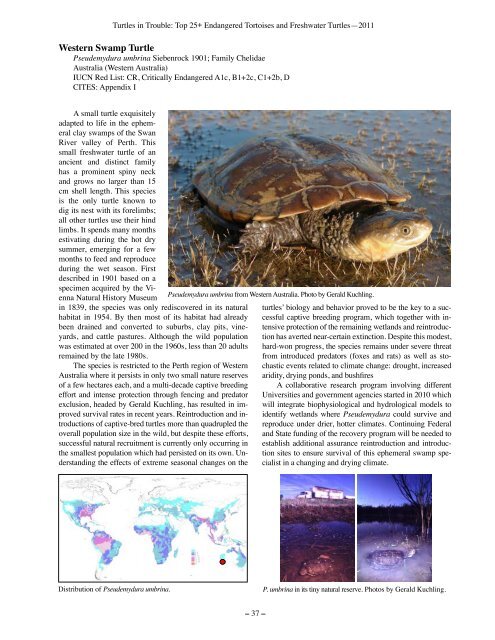Turtles in Trouble: The World's 25+ Most Endangered - Wildlife ...
Turtles in Trouble: The World's 25+ Most Endangered - Wildlife ...
Turtles in Trouble: The World's 25+ Most Endangered - Wildlife ...
- No tags were found...
Create successful ePaper yourself
Turn your PDF publications into a flip-book with our unique Google optimized e-Paper software.
<strong>Turtles</strong> <strong>in</strong> <strong>Trouble</strong>: Top <strong>25+</strong> <strong>Endangered</strong> Tortoises and Freshwater <strong>Turtles</strong>—2011Western Swamp TurtlePseudemydura umbr<strong>in</strong>a Siebenrock 1901; Family ChelidaeAustralia (Western Australia)IUCN Red List: CR, Critically <strong>Endangered</strong> A1c, B1+2c, C1+2b, DCITES: Appendix IA small turtle exquisitelyadapted to life <strong>in</strong> the ephemeralclay swamps of the SwanRiver valley of Perth. Thissmall freshwater turtle of anancient and dist<strong>in</strong>ct familyhas a prom<strong>in</strong>ent sp<strong>in</strong>y neckand grows no larger than 15cm shell length. This speciesis the only turtle known todig its nest with its forelimbs;all other turtles use their h<strong>in</strong>dlimbs. It spends many monthsestivat<strong>in</strong>g dur<strong>in</strong>g the hot drysummer, emerg<strong>in</strong>g for a fewmonths to feed and reproducedur<strong>in</strong>g the wet season. Firstdescribed <strong>in</strong> 1901 based on aspecimen acquired by the ViennaNatural History Museum<strong>in</strong> 1839, the species was only rediscovered <strong>in</strong> its naturalhabitat <strong>in</strong> 1954. By then most of its habitat had alreadybeen dra<strong>in</strong>ed and converted to suburbs, clay pits, v<strong>in</strong>eyards,and cattle pastures. Although the wild populationwas estimated at over 200 <strong>in</strong> the 1960s, less than 20 adultsrema<strong>in</strong>ed by the late 1980s.<strong>The</strong> species is restricted to the Perth region of WesternAustralia where it persists <strong>in</strong> only two small nature reservesof a few hectares each, and a multi-decade captive breed<strong>in</strong>geffort and <strong>in</strong>tense protection through fenc<strong>in</strong>g and predatorexclusion, headed by Gerald Kuchl<strong>in</strong>g, has resulted <strong>in</strong> improvedsurvival rates <strong>in</strong> recent years. Re<strong>in</strong>troduction and <strong>in</strong>troductionsof captive-bred turtles more than quadrupled theoverall population size <strong>in</strong> the wild, but despite these efforts,successful natural recruitment is currently only occurr<strong>in</strong>g <strong>in</strong>the smallest population which had persisted on its own. Understand<strong>in</strong>gthe effects of extreme seasonal changes on thePseudemydura umbr<strong>in</strong>a from Western Australia. Photo by Gerald Kuchl<strong>in</strong>g.turtles’ biology and behavior proved to be the key to a successfulcaptive breed<strong>in</strong>g program, which together with <strong>in</strong>tensiveprotection of the rema<strong>in</strong><strong>in</strong>g wetlands and re<strong>in</strong>troductionhas averted near-certa<strong>in</strong> ext<strong>in</strong>ction. Despite this modest,hard-won progress, the species rema<strong>in</strong>s under severe threatfrom <strong>in</strong>troduced predators (foxes and rats) as well as stochasticevents related to climate change: drought, <strong>in</strong>creasedaridity, dry<strong>in</strong>g ponds, and bushfiresA collaborative research program <strong>in</strong>volv<strong>in</strong>g differentUniversities and government agencies started <strong>in</strong> 2010 whichwill <strong>in</strong>tegrate biophysiological and hydrological models toidentify wetlands where Pseudemydura could survive andreproduce under drier, hotter climates. Cont<strong>in</strong>u<strong>in</strong>g Federaland State fund<strong>in</strong>g of the recovery program will be needed toestablish additional assurance re<strong>in</strong>troduction and <strong>in</strong>troductionsites to ensure survival of this ephemeral swamp specialist<strong>in</strong> a chang<strong>in</strong>g and dry<strong>in</strong>g climate.Distribution of Pseudemydura umbr<strong>in</strong>a.P. umbr<strong>in</strong>a <strong>in</strong> its t<strong>in</strong>y natural reserve. Photos by Gerald Kuchl<strong>in</strong>g.– 37 –







![RaLand / SeaScape [PDF] - Wildlife Conservation Society](https://img.yumpu.com/49974326/1/190x245/raland-seascape-pdf-wildlife-conservation-society.jpg?quality=85)








